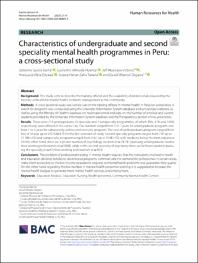Mostrar el registro sencillo del ítem
“Characteristics of undergraduate and second speciality mental health programmes in Peru: a cross‑sectional study“
| dc.contributor.author | García‑Serna, Jackeline | |
| dc.contributor.author | Almeida‑Huanca, Guillermo | |
| dc.contributor.author | Huarcaya‑Victoria, Jef | |
| dc.contributor.author | Vilela‑Estrada, Ana Lucia | |
| dc.contributor.author | Zafra‑Tanaka, Jessica Hanae | |
| dc.contributor.author | Villarreal‑Zegarra, David | |
| dc.date.accessioned | 2023-05-22T19:05:29Z | |
| dc.date.available | 2023-05-22T19:05:29Z | |
| dc.date.issued | 2023-03-01 | |
| dc.identifier.uri | https://hdl.handle.net/20.500.13053/8610 | |
| dc.description.abstract | “Background This study aims to describe the training ofered and the availability of professionals required by the Ministry of Health for mental health problems management in the community. Methods A cross-sectional study was carried out on the training ofered in mental health in Peruvian universities. A search for programs was conducted using the University Information System database and universities’ websites, as well as using the Ministry of Health’s database on health personnel and data on the number of enrolled and current students provided by the University Information System database and the Transparency section of the universities. Results There were 214 undergraduate, 55 specialty and 7 subspecialty programmes, of which 39%, 47% and 100%, respectively, were ofered in the capital city. The duration ranged from 5 to 7 years for undergraduate programs and from 1 to 3 years for subspecialty and second specialty programs. The cost of undergraduate programs ranged from free of charge up to USD 6863.75 for the frst semester of study. Second specialty programs ranged from 720 up to 11 986 USD and subspecialty programs ranged from 2267 up to 9138 USD, with medicine being the most expensive. On the other hand, there are a greater number of psychology students (n=78 781) pursuing undergraduate studies than working professionals (n=5368), while in the second specialty of psychiatry there are far fewer students pursu‑ ing the specialty (n=67) than working professionals (n=454). Conclusions The problem of professional training in mental health requires that the institutions involved in health and education develop policies to decentralize programs, communicate the demand for professionals in certain areas, make them accessible to the low-income population, respond to mental health problems and guarantee their quality. On the other hand, regarding the low number of mental health personnel working, it is suggested to increase the mental health budget to generate more mental health services and employment.“ | es_PE |
| dc.format | application/pdf | es_PE |
| dc.language.iso | eng | es_PE |
| dc.publisher | BioMed Central Ltd | es_PE |
| dc.rights | info:eu-repo/semantics/openAccess | es_PE |
| dc.rights.uri | https://creativecommons.org/licenses/by/4.0/ | es_PE |
| dc.subject | Education Medical, Education Nursing, Health personnel, Community Mental Health Centers | es_PE |
| dc.title | “Characteristics of undergraduate and second speciality mental health programmes in Peru: a cross‑sectional study“ | es_PE |
| dc.type | info:eu-repo/semantics/article | es_PE |
| dc.identifier.doi | " https://doi.org/10.1186/s12960-023-00805-9" | |
| dc.type.version | info:eu-repo/semantics/publishedVersion | es_PE |
| dc.publisher.country | GB | es_PE |
| dc.subject.ocde | 3.00.00 -- Ciencias médicas, Ciencias de la salud | es_PE |
Ficheros en el ítem
Este ítem aparece en la(s) siguiente(s) colección(es)
-
SCOPUS [380]


